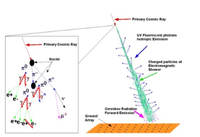Cosmic Rays reveal that we live in a dynamical universe, one punctuated with enormously energetic violent events.
In a previous post, I described what cosmic rays (CRs) are. Here, I focus on Ultra-high-energy CRs (UHECRs) and Extremely energetic CRs (EECRs) with kinetic energies greater than 1.0 EeV and 50 EeV, respectively. Energy notations are given in the attached figure. For comparison, a particle with 20 EeV has the same energy as the electrical shock delivered by a defibrillator and a 300 EeV particle equal to a baseball (142 gm., 5 ounces) traveling at 100 km/hr (60 mph).
While low-energy CRs are a dime a dozen, EECRs are needle-in-a-haystack rare events. Astroparticlephyicists normally have to resort to using the Earth as the primary detector. For example, sensors on board long-duration stratospheric-altitude balloon, staring at the Antarctica ice, watch for a single few-millisecond scintillation from an EECR interacting with the ice. More commonly, an EECR is detected from an avalanche shower produced in the atmosphere, which are observed by several near-ultraviolet sensors spread over an area of a few square kilometers as pictured. EECRs are so rare that the Pierre Auger Observatory in Argentina observed 27 events between 2004 and 2007. That’s about one event every four weeks for an observatory that is 3,000 square-km in size. Multiple secondary sensing sites reveals the path of the incoming EECR to determine its astronomical point of origin, but normally to ~1 degree of accuracy.
What are the sources of EECRs? That’s yet to be determined definitively. EECRs cannot travel over vast cosmological distances since scattering by the 2.7 K cosmic background radiation would degrade the energies below the threshold. Forty percent (40%) are consistent with EECRs coming from nearby galaxies known as active galactic nuclei (AGNs), but that result is tentative because a 1-degree uncertainty for sky location is not sufficiently accurate. An AGN is a gas-rich galaxy with a supermassive black hole at the center, in which material is falling into the BH and enormously energetic jets are throwing particles out at relativistic speeds. It is likely that some EECRs are iron nuclei (26 times ionized iron atoms) that have been centrifugally accelerated in AGN. Another possibility is that some EECRs are the result of the decay of superheavy dark matter particles. Anyway, it’s a largely unsolved mystery. Stay tuned to your local news stations for future press releases. Wait with baited breath for new results.

Enjoy being online again!
Welcome to the community of good people who base their values on evidence and appreciate civil discourse - the social network you will enjoy.Create your free account
Enjoy being online again!
Welcome to the community of good people who base their values on evidence and appreciate civil discourse - the social network you will enjoy.Create your free account








